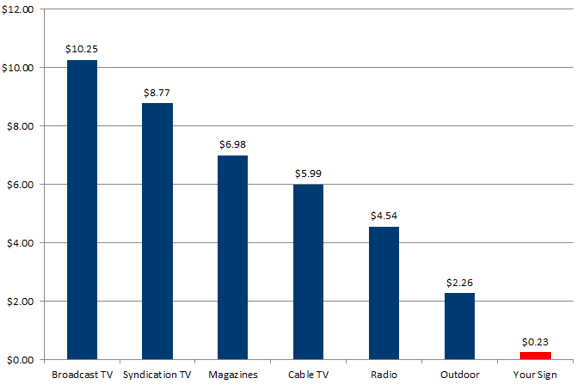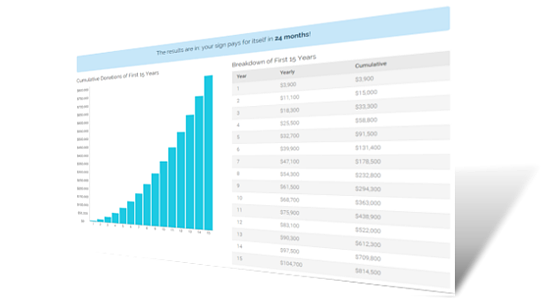Why Invest in a New Business Sign?
We understand that the cost of a new sign is an investment for your business. As the leading provider to businesses, churches and schools world-wide, we have seen first hand how these signs can positively affect the profitability and financial health of an organization like yours.
For businesses that choose to enhance their signage with an electronic message display, the owners typically see an increase in business of 15% to 150%.
U.S. Small Business Administration and the Signage Foundation for Communication Excellence, Inc. - "Electronic Message Centers (EMCs)"
Your Return-on-Investment
Want a free analysis of how soon your business sign could pay for itself? Using SBA statistics and information from your business, our sign experts can create a projection based on a sign designed for your needs. Just request a Quick Quote to get started!
The True Cost of a Sign
A sign is the only advertising medium that a company OWNS; a fixed expenditure on a permanent asset. All other forms of advertising are temporary and a repeated expense. Spread across its lifetime, a sign delivers a much lower cost-per-thousand exposure than other advertising mediums.
In addition, the advertising landscape has changed drastically in recent years, and this change only continues to accelerate. Traditional forms of marketing are becoming less effective and new forms of advertising are becoming increasingly expensive.
- Newspapers and other periodicals show a continued decline in readership. In a six month period ending in March 2010, overall Sunday circulation dropped 6.5% and weekday circulation dropped 8.7% as compared to the previous year. 6
- The number of TV channels have multiplied, shrinking individual channel viewership. In addition, the introduction of DVR technology allows viewers to skip over ads. DVR ownership has nearly tripled in the past three years to over 30 million, and more than half of users skip over ads. 7
- Terrestrial radio has declined almost 9% in both listeners and time spent listening, as non-commercial alternatives such as satellite radio and personal music players like the iPod gain more prominence. 10
- Internet use is on the rise, but increasing world-wide competition through a handful of channels has caused skyrocketing costs.
It is not uncommon for a business that is already using a variety of media advertising without an electronic message center to divert some of those advertising dollars to an investment in one of these displays, greatly increasing exposure, business volume and customer acquisition - all without spending any additional revenue.
U.S. Small Business Administration 2

*Direct mail cost-per-thousand is $300+ depending on postage rate, printing and list costs.
The Moving Target
America continues to be an extremely mobile society. The average vehicle is driven 220 miles per week, for a total of nearly 3 trillion miles of road traveled per year for the entire country. 9 This equates to an average of over 540 hours of drive time per year per driver. These drivers constitute a captive audience to sign marketing.
In addition, with an average of 18% of households relocating per year, a constant erosion of the established customer base is occurring.1 However, this shift also represents an ongoing opportunity to capture new clientele as they relocate within the trade area. Surveys have shown that over half of new customers were first exposed to a business through the sign.
During a two-year study, 165 independent small businesses surveyed between 15 and 30 of their first-time customers or clients to determine what prompted their first visit. In all, 2,475 new customers were surveyed. When asked the question "How did you learn about us?", fifty percent responded that the company's sign was their first exposure to the business. Hence, a business's sign can be estimated to generate between 15 percent and 45 percent of a small firm's revenue.
U.S. Small Business Administration 8
The Power of the Impulse Stop
A sign may be observed for later recall or it may prompt an immediate reaction and unplanned stop. The 'impulse' trade is often the difference between profitability and business failure.
U.S. Small Business Administration 3
Purchases that are a result of an unplanned impulse stop are a critical sales component for most businesses. An Institute of Transportation Engineers report estimates unplanned stops to be 20% to 45% of traffic for many businesses, depending on land use. 3
Without effective signage, the probability of an impulse stop and purchase is greatly reduced. Also, unlike all other forms of advertising, a business sign is in direct proximity with the business. This allows the impulse to be acted upon with the promise of immediate gratification, either with a physical product or the performance of a service.
| Business Land Use | Traffic that is Impulse Stop |
| Service Station | 45% |
| Convenience Market | 40% |
| Fast Food Restaurant | 40% |
| Small Shopping Center (<100K sq.ft.) | 35% |
| Large Shopping Center (>400K sq.ft.) | 30% |
| Mid Shopping Center (100K-400K sq.ft) | 25% |
| Sit Down Restaurant | 25% |
| Discount Club/Warehouse Store | 20% |
| Supermarket | 20% |
The Speed of Business
The ability of a business to react to changing market conditions is a large component of its success. Traditional advertising requires an outlay of money and time for content creation and redistribution each time the message is changed, and can take days, weeks or months to be put into effect.
A sign can be changed on-demand and at no cost to reflect up-to-the-minute conditions. Adjust immediately to competition, reduce perishable or other unwanted inventory, and take advantage of local trends and news.
Image Matters
The sign is a reflection of its business. It is the very first impression the business will project; a "salesman on the street" that extends the offerings into the vehicles passing by. The sign's effectiveness is directly related to its visibility, readability and attractiveness. No other single item can enhance the image of the business to more people.
An effective and attractive sign also functions as a tool for branding, increasing the name recognition and awareness of the business to the public. For those drivers that do not convert immediately into a sale, the business name and location are reinforced on every pass.
People often judge a business by how it looks on the sign.
U.S. Small Business Administration 1
Sources
- [1] U.S. Small Business Administration Marketing FAQs
- [2] "Electronic Message Centers (EMCs)" - The U.S. Small Business Administration and the Signage Foundation for Communication Excellence, Inc.
- [3] "SIGNS: Showcasing Your Business on the Street. The Importance of Signage for Your Business" - Prepared for the U.S. Small Business Administration By R. James Claus, Ph.D. and Susan L. Claus.
- [4] Media CPM by Jefferies & Company, Media Dynamics, InterMedia Dimensions and company reports, "Snapshot of the Global Media Landscape", provided to eMarketer, February 2009.
- [5] "Your Sign" based on sign investment of $10,000 over 15 year lifetime with monthly electrical cost of $13 and 10,000 views per day.
- [6] Audit Bureau of Circulations, Audience-FAX eTrend
- [7] "How DVRs are Changing the Television Landscape", The Neilson Company
- [8] "Commercial Signage and Its Importance to Small Business" SBA, The Small Business Advocate: Vol. 22, No. 2
- [9] "Highway Statistics 2008", Federal Highway Administration
- [10] "Persons Using Radio Report", Arbitron, Inc. Fall 1998-Spring 2007.
